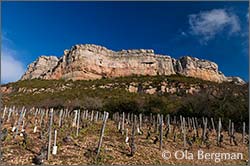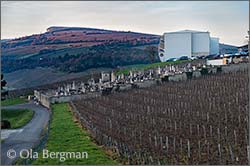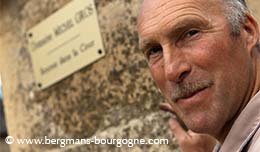
he village of Vergisson is the northern end of the mighty Pouilly-Fuissé appellation in the Mâconnais. Domaine Jacques Saumaize is one of the close to 30 domaines in the village. They believe in vinifying all parcels separately and they are one of the few in the village to harvest everything by hand.
– For our old vines Pouilly-Fuissé cuvée we use a large number of parcels across the appellation, in Vergisson, Solutré and Fuissé, says Anthony Saumaize. Many parcels are just between 0.10 ha and 0.15 ha. With the exception of three parcels in Solutré all are vinified separately.
Anthony Saumaize joined the family domaine in 2012 after a stint in construction work, wine school in Davayé and an internship in South Africa.
 – After South Africa I wanted to continue in New Zeeland, he says. But I was offered to take on three hectares of vines, so I decided to return home instead.
– After South Africa I wanted to continue in New Zeeland, he says. But I was offered to take on three hectares of vines, so I decided to return home instead.
His parents had created Domaine Jacques & Nathalie Saumaize in 1981. Jacques brought half of his family domaine, Domaine Léon Saumaize, which he had split with his brother Roger. In addition to that Nathalie brought vineyards from her family. When Anthony joined them in 2012 he brought his three hectares of wines, adding up to a total of 13 hectares, and the name was shortened to Domaine Jacques Saumaize.
– We don’t use machines a lot, explains Anthony Saumaize. Most of the work is done by hand, so 13 hectares is just about what you can manage. We are not certified organic, but we are moving in that direction. 20 years ago my father started ploughing. Even my grandfather Léon did a bit of ploughing in his day. My father used to plough the easier parts. Today we plough all vineyards.
 – We have a lot of old vines, which is one reason why we harvest by hand. Using a harvest machine would be disastrous. It would destroy the vines and we would have to replant everything.
– We have a lot of old vines, which is one reason why we harvest by hand. Using a harvest machine would be disastrous. It would destroy the vines and we would have to replant everything.
As is often the case in this part of Burgundy Domaine Jacques Saumaize is all about white wine. They work two of the five village appellations in the Mâconnais – Pouilly-Fuissé and Saint-Véran – as well as the regional appellation Mâcon. Most of the wines see wood, but never more than 20 per cent new oak.
 – The choices we make depend on the age of the parcels, says Anthony Saumaize. For all the old vines it’s 100 per cent in barrel, but just 20 per cent new ones. For the Mâcon wines it’s part barrel and part tank. For the Mâcon-Bussières we use standard sized barrels for half the cuvée and 400-litre barrels for the other half. For the Saint-Véran, En Crèches it’s 100 per cent in epoxy tank.
– The choices we make depend on the age of the parcels, says Anthony Saumaize. For all the old vines it’s 100 per cent in barrel, but just 20 per cent new ones. For the Mâcon wines it’s part barrel and part tank. For the Mâcon-Bussières we use standard sized barrels for half the cuvée and 400-litre barrels for the other half. For the Saint-Véran, En Crèches it’s 100 per cent in epoxy tank.
The Mâcon-Bussières comes from two parcels in the commune of Bussières bordering on the Pouilly-Fuissé appellation, one 40 years old and one 80 years old. The grapes from the younger vines end up in the 400-litre barrels and the ones from the old vines see the 228-litre barrels.
 For the Mâcon appellation the name of the village may be added in some cases. Hence a Mâcon-Bussières is a Mâcon from Bussières, a village to the immediate north of Vergisson, and a Mâcon-Vergisson is a Mâcon from Vergisson. The Mâcon-Vergisson by Domaine Jacques Saumaize also specifies the name of the lieu-dit, Sur la Roche.
For the Mâcon appellation the name of the village may be added in some cases. Hence a Mâcon-Bussières is a Mâcon from Bussières, a village to the immediate north of Vergisson, and a Mâcon-Vergisson is a Mâcon from Vergisson. The Mâcon-Vergisson by Domaine Jacques Saumaize also specifies the name of the lieu-dit, Sur la Roche.
– Mâcon-Vergisson, Sur la Roche is part of the three hectares I brought with me in 2012, says Anthony Saumaize. It is much higher up than the Bussières. Sur la Roche is on the slope of Roche de Vergisson.
Next to Sur la Roche, but across the border in Saint-Véran is a lieu-dit called En Crèches. From this plot Anthony Saumaize produces two cuvées. One Saint-Véran, En Crèches and one Saint-Véran, La Vieille Vigne des Crèches.
– There is a lot of limestone in En Crèches, says Anthony Saumaize. It is shaped a bit like an amphitheatre. The young vines get the rising sun and the old vines the setting sun. The grapes of the old vines usually ripen two or three days before the young ones.
 While the younger Saint-Véran cuvée is made in tanks, the old vines cuvée is all barrels, 20 per cent new. The third Saint-Véran cuvée, from the lieu-dit Poncetys just next to the wine school in Davayé, is completely different i terms of soil.
While the younger Saint-Véran cuvée is made in tanks, the old vines cuvée is all barrels, 20 per cent new. The third Saint-Véran cuvée, from the lieu-dit Poncetys just next to the wine school in Davayé, is completely different i terms of soil.
– It is clay and limestone, explains Anthony Saumaize. The clay is dominating. It is a gentle slope just southeast of the lycée viticole. This is where the oldest vines of the domaine are. Low yielding – 35 hl/ha to 40 hl/ha – and planted in 1944 and 1945.
In 2015 they added some Saint-Véran, Les Cras. This parcel has never been ploughed and it has required a lot of work in order to meet the standards of the domaine. The first vintage was in 2016.
The Pouilly-Fuissé appellation is represented at Domaine Jacques Saumaize by seven different bottlings – two blends and five lieux-dits. The cuvée named Nuance is a blend of two very young parcels planted in 2006 and 2008.
 – The two parcels – Au Métertière and En Servy – are vinified separately, says Anthony Saumaize. We use 400-litre barrels that have been used for two to five vintages. En Servy is below the Roche de Solutré facing south, so it earlier ripening than Au Métertière, which is higher in altitude.
– The two parcels – Au Métertière and En Servy – are vinified separately, says Anthony Saumaize. We use 400-litre barrels that have been used for two to five vintages. En Servy is below the Roche de Solutré facing south, so it earlier ripening than Au Métertière, which is higher in altitude.
One of the parcels Anthony Saumaize brought with him in 2012 was the Pouilly-Fuissé, Les Scélés. There is no limestone in this part of the appellation. This is schist soil.
– It is a wine with much less freshness and roundness. It is more about fruit and it is not a wine for keeping. It is a bit particular, but still worth bottling separately as long as it is drunk quite quickly.
Then in Les Creuzettes, on the back of the Roche de Solutré, there is a lot of limestone. There is just ten centimetres of soil before you hit the rock. The wine is made from two parcels, 50 to 60 years old, one that Anthony Saumaize brought and one that used to go into the old vines Pouilly-Fuissé.
– In La Maréchaude, on the southern side of Roche de Vergisson, the soil is a lot deeper. It is between one and one and a half metre. We have three parcels, where the oldest is 80 years old.
– On the opposite side of Vergisson we have Les Courtelongs. It is on a north facing slope, but its well-protected by the Roche de Vergisson. It never gets too cold there. The vines are 60 years old and the soil very deep. After digging two metres we still haven’t found the rock. The wine needs a few years in bottle to come around.
© 2017 Ola Bergman














